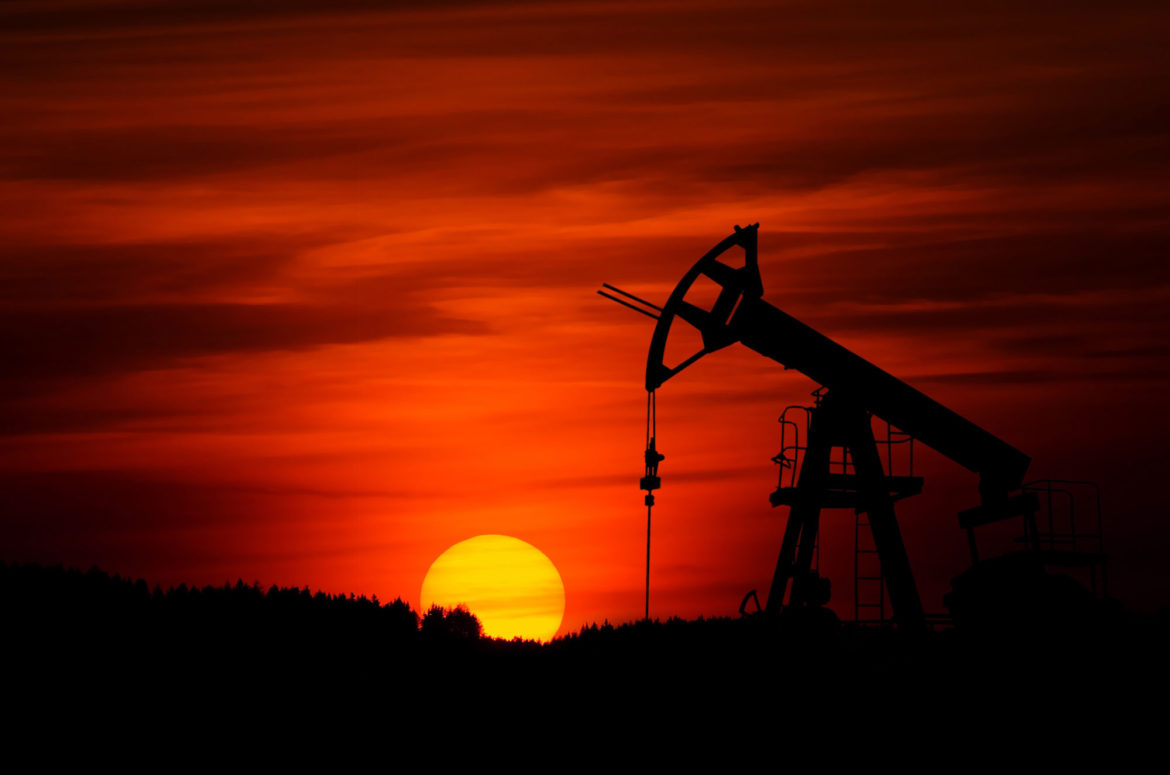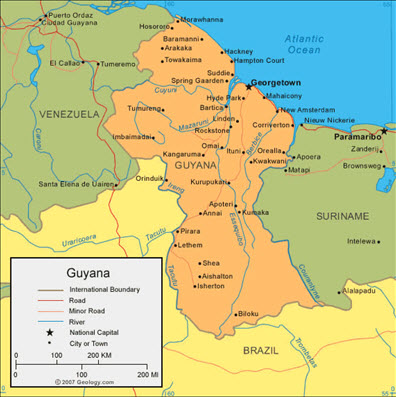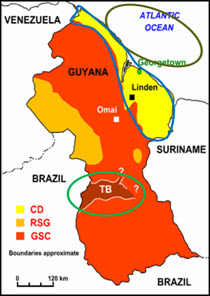
Energy / Oil and Gas
Legal developments in the Oil and Gas industry in Guyana
History of Guyana

- The first peoples who first inhabited Guyana were a combination of Caribs and Arawaks who migrated from the south of the continent of South America
- In 1498 Guiana was first spotted by Columbus.
- In 1499 Alonso de Ojeda led a Spanish expedition up the Essequibo river.
- First European colonizers were the Dutch in 1616
- In the 1650s the Dutch introduced the enslaved Africans .
- In 1781 British held the territory briefly then the French for two years.
- 1783 the Dutch resumed control.
- 1814 the territory was ceded to the British at the London Convention and the country became British Guiana.
- Guyana became independent on May 26th 1966
- At the time of independence the head of State was the Governor General who was the Queen’s representative.
- In 1970 Guyana became a Republic.
Legal system
- Guyana is a common law jurisdiction.
- There are four levels of the judiciary.
- Magistrates Court.
- High Court of the Supreme Court of Judicature
- Court of Appeal
- Caribbean court of Justice. (Located in Trinidad and Tobago)
Statistics
- Population 750000
- 83000 sq. miles/ 215 sq. kilometers
- GDP 446 billion USD
- GDP per capita. USD8394.3
- Main exports gold, rice, sugar, bauxite and timber.
Courts
- Guyana Courts recognize choice of law clauses
- Guyana Courts recognize choice of jurisdiction clauses.
- Guyana Courts recognize and uphold arbitration clauses.
- Very limited reciprocal enforcement of foreign judgments. It is subject to the issuance of a list of approved counties issued by the Minister.
Guyana Oil landscape
Guyana has two main petroleum provinces:

- Guyana Basin – situated in Guyana’s Maritime Area and is ~120,000 sq.km. It can be divided into two parts : coastal onshore basin fringe and offshore basin. Most of the basin lies offshore Guyana
- Takutu Basin – situated in south central Guyana. Is shared with neighbouring Brazil measuring ~280 km (174 miles) long from Boa Vista, Brazil to the Essequibo River of Guyana: ~40 km (25 miles) wide and ~6km (4miles) deep. (Crawford et. al,1983). It has an area of ~9800 sq. km in Guyana.
Discovery of Oil and Gas
- In May 2015 Exxon announced the discovery of oil in commercial quantities initially on its Stabroek Block initially estimated at 800 million barrels.
- Subsequent discoveries have now placed it at 2.5 billion barrels of oil.
- Country has no history of the production of oil and or gas.
WHERE DID WE FIND IT
- 120 MILES OFFSHORE
- 6680 feet of water and 18080 feet below the sea bed
- Described as deep sea
Major operators in the Oil and Gas industry
- Exxon holds the largest block. They have signed PSA with the Government and expect to commence production of 100000 barrels per day in 2020
- Repsol holds off shore blocks, has recently concluded seismics and will commence drilling in Q1 2018
- Tullow has just concluded seismics.
- CGX listed on the Toronto FX.
- Other smaller holders of off shore blocks.
Current Legislative framework
- PETROLEUM (EXPLORATION AND PRODUCTION ) ACT 1986.
- This Act applies to the exploration, exploitation, conservation and management of petroleum existing in its natural condition in land in Guyana, including the territorial sea, continental shelf and exclusive economic zone of Guyana.
Scheme of the Petroleum Act 1986
- Application for a prospecting licence Section 20
- Grant of prospecting licence. Section 21.
- Notification of discovery of oil. Section 30
- Notification of discovery of oil in commercial quantities. Section 31
- Application for a petroleum production licence. Section 34
- Grant of petroleum production licence. Section 35
The licence
- Granted for a period of maximum of twenty years
- Single renewal for a period not exceeding 10 years. Section 39 and 40
- Prospecting licence issued to Exxon was issued in 1999 and attached to it the draft production sharing agreement.
- A production licence, grants the following ..
- (a) to carry on prospecting and production operations in the production area
- (b) to sell or otherwise dispose of petroleum recovered; and
- (c) to carry on such operations and execute such works in the production area as are necessary for, or in connection with, any matter referred to in paragraph (a) or (b).
Royalty and taxes
- Exxon’s royalty was 1% under the 1999 agreement
- In 2016 it was increased to 2%
- No taxes.
- 50% profit sharing after expenses.
Proposed legislative changes
In 2017 the Government introduced to the National Assembly a draft Petroleum Commission of Guyana Bill. The Bill proposes to establis h a National Petroleum Commission. The Bill was sent to select committee for wider consultation.
Proposed functions of the Commission
The function of the Commission is to promote, monitor and regulate the efficient, safe, effective and environmentally sustainable exploration, development and production of petroleum in Guyana.
Responsibility of the Commission
- The Commission shall be responsible for –
- (a) the enforcement of the conditions of exploration and production leases, concessions or exclusive permissions, or any licence, permit or production sharing or joint venture agreement entered into or deemed to be granted or entered into under the Petroleum (Exploration and Production) Act Chapter 65:01.
- (b) the collection and recovery of all rents, fees, royalties, penalties, levies, tolls and any other charges payable under the Petroleum (Exploration and Production) Act Chapter 65:01 and any other revenues of the Commission Section 4 (4).
Environmental protection
- Environmental Protection Act chapter 20:05 (1996) of the laws of Guyana established the EPA.
- Section 3. (1)” There is hereby established the Environmental Protection Agency which shall be a body corporate governed by a Board of Directors.
Functions of the EPA
(1) The functions of the Agency are—
- (a) to take such steps as are necessary for the effective management of the natural environment so as to ensure conservation, protection, and sustainable use of its natural resources;
- (b) to promote the participation of members of the public in the process of integrating environmental concerns in planning for developmenton a sustainable basis;
- (c) to co-ordinate the environmental management activities of all persons, organisations and agencies;
- (d) to establish, monitor and enforce environmental regulations;
- (e) to prevent or control environmental pollution;
- (f) to co-ordinate an integrated coastal zone management programme;
- (g) to ensure that any developmental activity which may cause an adverse effect on the natural environment be assessed before such activity is commenced and that such adverse effect be taken into account in deciding whether or not such activity should be authorised;
- (h) to co-ordinate and maintain a programme for the conservation of biological diversity and its sustainable use;
- (i) to co-ordinate the establishment and maintenance of a national parks and protected area system and a wildlife protection management programme;
- (j) to promote and encourage a better understanding and appreciation of the natural environment and its role in social and economic development;
- (k) to establish and co-ordinate institutional linkages locally, nationally, regionally and internationally;
- (l) to play a co-ordinating role in the preparation and implementation of cross-sectoralprogrammes of environmental contents;
- (m) to advise the Minister on the criteria and thresholds of activity for specifying what may amount to a significant effect on the environment;
- (n) to advise the Minister on matters of general policy relating to the protection, conservation and care of the environment
- (o) to perform such other functions pertaining to the protection of the environment as may be assigned to it by the Minister by or under this Act or any other law.
Prevention and control of pollution
- (1) A person shall not—
- (a) undertake an activity that causes or is likely to cause pollution of the environment unless the person takes all reasonable and practicable measures to prevent or minimise any resulting adverse effect;
Principles to be applied
- (4) In performing its functions the Agency shall make use of current principles of environmental management, namely—
- (a) the “polluter pays” principle: the polluter should bear the cost of measures to reduce pollution decided upon by public authorities, to ensure that the environment is in an acceptable state, and should compensate citizens for the harmthey suffer from pollution;
- (b) the “precautionary” principle: where there are threats of serious or irreversible damage, lack of full scientific certainty shall not be used as a reason for postponing measures to prevent environmental degradation;
- (c) the “strict liability’’ legal principle: any person who contravenes this Act or regulations shall be liable to the penalties prescribed therefor;
- (d) the “avoidance” principle: it is preferable to avoid environmental damage as it can be impossible or more expensive to repair rather than prevent damage;
- (e) the “state of technology” principle: measures protecting the environment are restricted by what is technologically feasible and as technology improves, the improved technology should be used to prevent and repair environmental damage.
Prevention and control of pollution
- 19 (b) Any person who contravenes subsection (l)(b) shall be guilty of an offence and shall be liable to the penalties prescribed under paragraph (e) of the Fifth Schedule.
- (3) Where subsection (1) is contravened the person responsible for the contaminant or for the process involving the contaminant or who causes or permits a discharge in contravention of subsection (1) shall— immediately notify the Agency
- (c) be liable to pay for the cost of an independent investigation into the discharge;
- (d) deposit with the Agency a sum of money equal to the estimated costs of restoration and investigation;
- (e) be liable to compensate any person who suffers any loss or damage as a result of any contravention ofsubsection (1);
- (f) do everything practicable to preserve, for investigation, evidence of the effects of the discharge.
Defintions under the act
- “contaminant’’ means any solid, liquid, gas, odour, sound, vibration, radiation, heat or combination of any of them resulting directly or indirectly from human activities that may cause an adverse effect;
- “loss or damage” includes personal injury, loss of life, loss of use or enjoyment of property and pecuniary loss, including loss of income;
- “pollution of the environment” and “environmental
- pollution’’ mean pollution of the environment by the release into the natural environment of any contaminant;
- “person responsible”, in relation to any project, enterprise, construction or development, includes any person who owns, operates, or exercises economic power or control over or at whose order or on whose behalf the project, enterprise, construction or development will be or, as the case may be, is being undertaken;
Who may sue
Any person who has suffered loss or damage as a result of the commission by any other person of any offence under this Act or any conduct that is contrary to this Act or the regulations may, in the High Court, sue for the recovery from the person who committed the offence or engaged in the conduct an amount equal to the loss or damage proved to have been suffered by the person and an amount to compensate for the costs of any investigation in connection with the matter and of proceedings under this section.
Preventative relief
Interlocutory relief by way of injunction can be obtained where there is an anticipation of a breach
Treaties
- The International Convention for the Prevention of Pollution from Ships (“MARPOL”) . Ratified.
- Convention on Oil Pollution Preparedness, Response and Co-Operation (“OPRC”) Ratified
- International Convention on Civil Liability for Oil Pollution Damage . 1969 convention ratfied. 1992 protocol not yet ratified.
- The Convention on Limitation of Liability for Maritime Claims. Ratified
Territorial disputes
- Guyana has a territorial dispute with Venezuela in which Venezuela claims 5/8 of Guyana in the west of the country
- The dispute arose out of the 1899 treaty which settled and perfected the boundaries between Guyana and Venezuela.
- The current good officers process at the UN will expire at the end of 2017 when dispute will be submitted to the ICJ.
